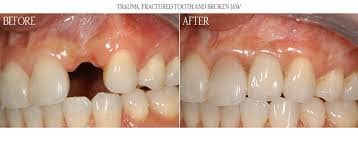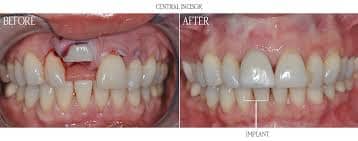
Anterior Implant Procedures
Anterior Implant Procedures: Replacing Teeth that Are Failing
Teeth supporting a traditional, tooth-supported bridge often fail over time and the bridge must be replaced. The failure can be the result of significant decay, failed root canal therapy, or fracture of one or both of the teeth supporting the bridge. In these situations, dental implant treatment is the ideal option for most patients.
There are three steps in the treatment process:
- Surgical removal of the failed teeth, usually with bone grafting to maintain the natural contours of the bone and gum tissue
- Placement of the dental implants, either immediately after removal of the teeth, or several weeks following tooth removal
- Attachment of the final implant-supported bridge

Before and After

Before and After
Immediate Dental Implant Placement
The first step in the treatment process is the removal of the failed bridge, followed by a special surgical technique to remove the teeth while preserving the bone and gum tissue to create the ideal site for implant placement. Since this procedure is technique sensitive, it is usually performed by surgical specialists with extensive experience removing teeth in preparation for dental implants.
Immediately after the teeth are removed, dental implants are placed using a delicate surgical technique to avoid damaging the bone. Bone grafting material is often placed around the implants, filling in the sockets completely to maintain natural contours. The position of the dental implants is critical to ensure that the new crowns or bridge emerge from the gum tissue exactly like natural teeth and function properly. Due to the precision required for this procedure, the surgical specialist must be experienced with immediate anterior implant placement to ensure a successful outcome.
Delayed Dental Implant Placement
In cases where there is insufficient bone to stabilize the dental implants immediately following removal of the failed teeth, the surgical specialist could determine that it would be better to delay implant placement. A bone graft placed following tooth removal, as seen in the illustrations below, fills in the socket where the tooth root is missing, preserving the natural contours of the bone and gum tissues.
Replacing Teeth That Are Already Missing
In cases where the teeth have been missing for an extended period of time, the surgical specialist must determine whether there is sufficient bone remaining for placement of dental implants. Both the quality and quantity of bone where the dental implants will be placed must be evaluated. 3D cone beam images with computer-generated scans are often used to facilitate the diagnosis and treatment planning process, as they provide a more detailed look at the existing teeth, bone, nerves, and tissue with both three-dimensional and cross-sectional views.

